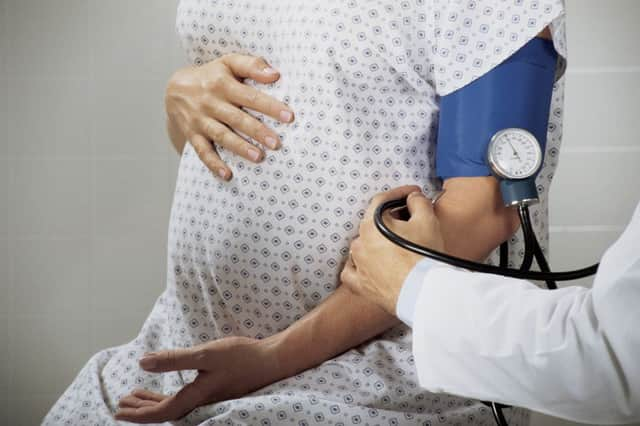Pregnant women to test their own blood pressure


A pilot study involving 30 women carried out by Tommy’s research centre at the Edinburgh Royal Infirmary used telemetric technology to transmit a blood pressure reading via Bluetooth to a secure website.
Around one in ten pregnant women in Scotland suffers from high blood pressure, also known as hypertension.
Advertisement
Hide AdAdvertisement
Hide AdCurrently women who have the condition are seen regularly by their GP, midwife or at a hospital triage department for monitoring.
But researchers hope that allowing women to test themselves at home could save the NHS time and money.
Telemetry is used to transmit messages in many industries, including the military, and by space organisations such as Nasa to collect data from spacecrafts and satellites.
In the Scottish study it allows the women to record their own blood pressure, with the results transmitted to a secure website only accessible by their midwife or doctor.
Researchers estimate that home blood pressure telemetry saves around £28 for each appointment and also reduces appointment times.
High blood pressure can be a side effect of pregnancy, particularly among older mothers or those who are overweight.
It is the most common medical problem in pregnancy, complicating up to 15 per cent of pregnancies and accounting for about a quarter of all antenatal admissions in the UK.
Although more cases of mild or moderate high blood pressure will not necessarily cause problems for mothers or babies, more severe cases can lead to pre-eclampsia, which can cause fits, blood clots, stroke, premature birth or stillbirth.
Advertisement
Hide AdAdvertisement
Hide AdThe earlier in pregnancy that a rise in blood pressure is recorded, the greater the chance of developing pre- eclampsia in the later stages.
Researchers at Tommy’s are now applying for further funding for a larger-scale project.
Fiona Denison, senior lecturer in maternal and foetal health, who co-ran the project, described the results as “promising”.
She added: “This has just been an initial pilot study to test whether it would be feasible. The small number of women that were tested were very keen and the feedback has been positive. Telehealth has huge potential. The next stage is to apply for additional funding for a bigger study.”
The study was yesterday welcomed by the Royal College of Midwives (RCM), which said home-testing could prove particularly useful to women living in rural areas.
Gillian Smith, director of the RCM in Scotland, said: “I think anything that allows women to stay at home and remain more mobile has to be a good thing.
“With some women, their blood pressure will actually go up just by coming in and being tested. It’s not just about cost-saving, but also about convenience for the women.
“It may be particularly useful to women who are living in rural parts of the country who struggle to attend appointments.
Advertisement
Hide AdAdvertisement
Hide Ad“This would not be a replacement for a routine antenatal appointment where a lot more than blood pressure is checked, and if something was wrong then the women would be brought in and seen.”
But Elsie Gayle, independent midwife and lead midwife for the Patients First campaign group, said the NHS should be cautious about implementing home-testing.
She said: “I believe that each woman ought to be properly monitored, and I am inclined to recommend the majority of monitoring needs to be face to face for a full assessment – to ensure the safety of the individual mother and her pregnancy.
“It may not be cost-saving in the longer term to utilise IT methodologies, which have proved suitable for some types of chronic disease, in order to treat pregnancy conditions. Some disorders of pregnancy can also be masked by chronic hypertensive disease.
“Any mistakes or failures, whether human or technological, may in fact cause death or serious damage, both in the short or longer term – including disastrous impacts on the attending clinician.”
FOLLOW US
SCOTSMAN TABLET AND MOBILE APPS